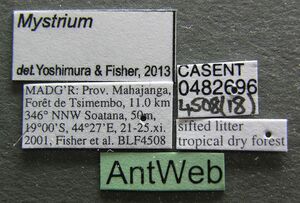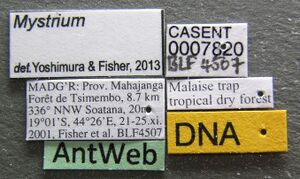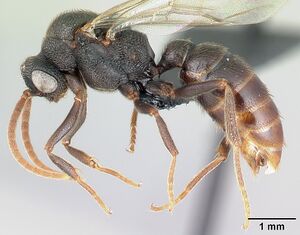Mystrium janovitzi
| Mystrium janovitzi | |
|---|---|

| |
| Scientific classification | |
| Kingdom: | Animalia |
| Phylum: | Arthropoda |
| Class: | Insecta |
| Order: | Hymenoptera |
| Family: | Formicidae |
| Subfamily: | Amblyoponinae |
| Tribe: | Amblyoponini |
| Genus: | Mystrium |
| Species group: | voeltzkowi |
| Species: | M. janovitzi |
| Binomial name | |
| Mystrium janovitzi Yoshimura & Fisher, 2014 | |
Nothing is known about the biology of Mystrium janovitzi.
Identification
The worker of Mystrium janovitzi is distinguished easily from that of the other Mystrium species by the combination of the following characters: the labrum lacking central longitudinal carina; low clypeal conical setae; the posterior face of the vertex forming a right angle with its dorsal face; wide pronotum covered with fine sculpture that is neither longitudinal nor reticulate. This combination of diagnostic characters for the worker is also useful for distinguishing ergatoid queens of M. janovitzi. The ergatoid queen of M. janovitzi is similar to conspecific workers in its sculpture and body color, but differs in having a narrower mandible with a straight apical tooth and distinct vestigial wings. For the male, small ocelli not strongly protruding from posterior margin of head in full-face view, rounded posterior margin of head in full-face view, smooth abdominal tergum VIII, and vertex strongly rising from neck separate M. janovitzi from other known Mystrium males in the Malagasy region. (Yoshimura and Fisher 2014)
Keys including this Species
Distribution
Latitudinal Distribution Pattern
Latitudinal Range: -12.53333° to -25.58767°.
| North Temperate |
North Subtropical |
Tropical | South Subtropical |
South Temperate |
- Source: AntMaps
Distribution based on Regional Taxon Lists
Malagasy Region: Madagascar (type locality).
Distribution based on AntMaps
Distribution based on AntWeb specimens
Check data from AntWeb
Countries Occupied
| Number of countries occupied by this species based on AntWiki Regional Taxon Lists. In general, fewer countries occupied indicates a narrower range, while more countries indicates a more widespread species. |

|
Estimated Abundance
| Relative abundance based on number of AntMaps records per species (this species within the purple bar). Fewer records (to the left) indicates a less abundant/encountered species while more records (to the right) indicates more abundant/encountered species. |

|
Biology
|
Castes
Worker
Images from AntWeb
   
| |
| Holotype of Mystrium janovitzi. Worker. Specimen code casent0482698. Photographer Estella Ortega, uploaded by California Academy of Sciences. | Owned by CAS, San Francisco, CA, USA. |
    
| |
| Queen (ergatoid). Specimen code casent0482696. Photographer Estella Ortega, uploaded by California Academy of Sciences. | Owned by CAS, San Francisco, CA, USA. |
Male
Images from AntWeb
      
| |
| Male (alate). Specimen code casent0007820. Photographer Estella Ortega, uploaded by California Academy of Sciences. | Owned by CAS, San Francisco, CA, USA. |
     
| |
| Male (alate). Specimen code casent0007826. Photographer Erin Prado, uploaded by California Academy of Sciences. | Owned by CAS, San Francisco, CA, USA. |
     
| |
| Male (alate). Specimen code casent0064213. Photographer Erin Prado, uploaded by California Academy of Sciences. | Owned by CAS, San Francisco, CA, USA. |
     
| |
| Male (alate). Specimen code casent0110785. Photographer Erin Prado, uploaded by California Academy of Sciences. | Owned by CAS, San Francisco, CA, USA. |
     
| |
| Male (alate). Specimen code casent0135946. Photographer Dimby Raharinjanahary, uploaded by California Academy of Sciences. | Owned by CAS, San Francisco, CA, USA. |
    
| |
| Male (alate). Specimen code casent0144988. Photographer Dimby Raharinjanahary, uploaded by California Academy of Sciences. | Owned by CAS, San Francisco, CA, USA. |
     
| |
| Male (alate). Specimen code casent0145028. Photographer Dimby Raharinjanahary, uploaded by California Academy of Sciences. | Owned by CAS, San Francisco, CA, USA. |

| |
| Specimen code casent0080644. . | |
Nomenclature
The following information is derived from Barry Bolton's Online Catalogue of the Ants of the World.
- janovitzi. Mystrium janovitzi Yoshimura & Fisher, 2014: 77, figs. 4D, 5D, 17A,C, 23A,C, 26D, 28D, 31B, 32B,D, 37D, 38D, 39D, 40D, 41D, 50B, 51B, 52B, 53B, 54B, 55B, 56B (w.ergatoid q.m.) MADAGASCAR.
- Type-material: holotype worker.
- Type-locality: Madagascar: Mahajanga, Forêt de Tsimembo, 11 km. 346° NNW Soatana (-18.99528°, 44.4435°), 50 m., 21-25.xi.2001, BLF04508, CASENT0482698 (Fisher-Griswold Arthropod Team).
- Type-depository: CASC.
- Distribution: Madagascar.
Unless otherwise noted the text for the remainder of this section is reported from the publication that includes the original description.
Description
Worker
Measurements: holotype. HL 1.74, HW 1.89, SL 1.13, ML 1.69, HD 1.25, WL 2.15, PnW 1.2, PpW 0.99, PtW 1.07, PtL 0.73, CI 108.5, SI 59.8, MI 89.5, PpI 82.5, PtI 146.
HL 1.40–2.27, HW 1.46–2.67, SL 0.90–1.61, ML 1.30–2.58, HD 1.01–1.79, WL 1.83–2.94, PnW 0.91–1.52, PpW 0.80–1.28, PtW 0.82–1.32, PtL 0.56–0.90, CI 101.6–117.5, SI 59.7–67.9, MI 67.0–103.1, PpI 84.3–94.6, PtI 138.7–160.3 (10 specimens measured).
Posterolateral corner of head moderately expanding posteriorly. Posterior face of vertex forming almost right angle with dorsal face on median line of head, so that declivity of vertex on median part even steeper than on lateral part. Ventral half of vertex sculptured. Eye usually large, but sometimes small. Anterior margin of clypeus straight with small, extremely low conical setae. Genal tooth of head undeveloped, anterolateral corner of head angled. Masticatory margin of mandible almost invisible in full-face view, and width of dorsal surface of mandible almost identical from mandibular shaft to distal portion. Second maxillary palpomere longer than third. First flagellomere (third antennal segment) about as long as pedicel (second antennal segment). Shallow, rough, and fragmented longitudinal reticulation irregularly impressed along the entire pronotal dorsum. Shallow, rough, and fragmented longitudinal reticulation irregularly impressed on lateral surface of pronotum. Mesonotum often not differentiated from propodeum in dorsal view, length as long as that of propodeum. Metanotal groove indistinct in lateral view. Metapleural gland bulla moderately developed, and propodeal declivity in lateral view almost straight though sometimes weakly rounded. Petiole relatively long (PtI 138.7–160.3), with slightly widened posterior 1/4 to 1/3 in dorsal view, anterior margin gently rounded or almost straight, and never edged by striae.
Body color black. Four distal segments of antennal club brighter.
Queen
Ergatoid Measurements: HL 1.32–1.77, HW 1.37–2.04, SL 0.99–1.34, ML 1.31–1.80, HD 0.99–1.35, WL 1.86–2.43, PnW 0.88–1.92, PpW 0.83–1.08, PtW 0.81–1.19, PtL 0.58–0.69, CI 103.9–114.8, SI 65.7–74.5, MI 88.5– 95.3, PpI 48.6–95.1, PtI 139.6–177.3 (10 specimens measured).
Wings vestigial and reduced to small appendages, which are sometimes indistinct. Wing sclerites undeveloped. Posterolateral corner of head moderately expanding posteriorly, expansion not differentiated from that of workers. Posterior face of vertex forming almost right or even slightly acute angle with dorsal face on median line of head, so that declivity of vertex on median part even steeper than on lateral part. Ventral half of vertex sculptured. Eye varied from well developed to small. Ocelli absent. Anterior margin of clypeus straight with extremely short and small conical setae. Genal tooth of head absent, corner usually unangled, sometimes angled into a small, short spine. Masticatory margin of mandible almost invisible in full-face view, and dorsal surface on distal portion as wide as that on mandibular shaft. Spatulate seta present on basal side of each basal denticle on masticatory margin of mandible. First flagellar segment on antenna as long as pedicel. Setae on pronotum usually narrowing distally, or sometimes widened distally, with strongly sharpened apex. Metapleural gland bulla less developed, not expanding to either dorsum of propodeal spiracle or propodeal declivity margin in lateral view, so that posterior margin of propodeum in lateral view almost straight. Petiole relatively long in dorsal view, about 0.8-1.0 × length of abdominal segment III.
Body color black.
Male
Measurements: HL 1.10–1.22, HW 1.52–1.72, SL 0.36– 0.42, EL 0.62–0.71, WL 2.45–2.96, MnW 1.57–1.76, CI 135.2–141.0, SI 21.2– 25.2, EI 54.1–58.1, MnI 99.3–103.9 (5 specimens measured).
Eye moderately large, occupying 0.6× head length. Ocelli reaching to dorsal margin of head in full-face view, or just failing to reach dorsal margin. Dorsal margin of head in full-face view rounded. Both anterior and lateral ocelli small. Lateral ocellus small and distant from eye: distance between these more than 2× maximum diameter of lateral ocellus. Posterior face of vertex rising steeply from neck, dorsal face slightly shorter than posterior face. Palpal formula 4,3. First segment of maxillary palp flattened and distinctly wider than second segment. Second maxillary palpomere longer than third. Notauli deeply to shallowly impressed on mesoscutum, but often unclear. Petiole in dorsal view thin, length 0.8–0.65× that of abdominal tergite III. Petiolar dorsum covered with shallow, sparse, irregular punctures, or almost smooth. Abdominal tergum VIII without deep punctures, almost smooth.
Distal portion of abdominal sternum IX smooth and not punctured. Basal ring long, distinctly extending basally. Telomere distinctly extending farther distally than digitus. Basoventral expansion of aedeagus moderately developed basoventrally, longer than dorsal extension. Ventral margin of aedeagus gently curved ventrally in lateral view. Aedeagus moderately narrowing distally on distal half, distal portion widely rounded.
On forewing, cu-a located far basal from junction of Media (M) and Cubitus (Cu).
Body color reddish brown to black.
Type Material
Holotype. Worker: CASENT0482698, BLF04508, MADAGASCAR, Mahajanga, Forêt de Tsimembo, 11.0 km 346° NNW Soatana (-18.99528°, 44.4435°), 50 m alt., 21–25.xi.2001, Fisher-Griswold Arthropod Team leg. California Academy of Sciences.
Etymology
The specific epithet is the patronym of Dr. Tyler Janovitz in recognition of his interest in myrmecology and his support for research on ants.
References
- Cantone S. 2017. Winged Ants, The Male, Dichotomous key to genera of winged male ants in the World, Behavioral ecology of mating flight (self-published).
- Yoshimura, M. & Fisher, B.L. 2014. A revision of the ant genus Mystrium in the Malagasy region with description of six new species and remarks on Amblyopone and Stigmatomma (Hymenoptera, Formicidae, Amblyoponinae). ZooKeys 394, 1–99.
References based on Global Ant Biodiversity Informatics
- Blaimer B. B., S. G. Brady, T. R. Schultz, and B. L. Fisher. 2015. Fucntional and phylogenetic approaches reveal the evolution of diversity in a hyper diverse biota. Ecography 38: 001-012.
- Yoshimura M., and B. L. Fisher. 2014. A revision of the ant genus Mystrium in the Malagasy region with description of six new species and remarks on Amblyopone and Stigmatomma (Hymenoptera, Formicidae, Amblyoponinae). ZooKeys 394: 1-99.

